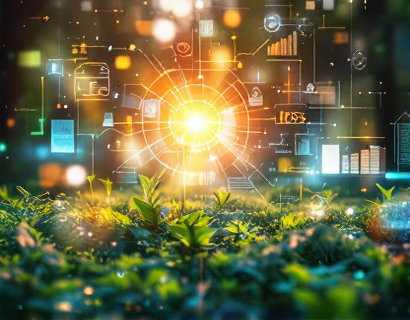Maximizing Yields and Sustainability in Horticulture Through Advanced Environmental Analytics
In the realm of horticulture, the pursuit of maximizing yields while maintaining sustainability is a complex challenge that requires innovative solutions. Advanced environmental analytics emerges as a pivotal tool in this endeavor, offering data-driven insights that optimize resource management and promote eco-friendly practices. This article delves into how these analytics can transform horticultural practices, ensuring a healthier planet for future generations.
The integration of advanced environmental analytics in horticulture is not merely a trend but a necessity. As the global population continues to grow, the demand for fresh produce increases, putting immense pressure on agricultural systems. Traditional methods often lead to overuse of resources, environmental degradation, and reduced long-term productivity. By leveraging sophisticated analytics, horticulturists can achieve a balance between high yields and environmental stewardship.
Understanding Environmental Analytics in Horticulture
Environmental analytics involves the collection, analysis, and interpretation of environmental data to inform decision-making. In horticulture, this data can include soil moisture levels, temperature, humidity, light intensity, and nutrient concentrations. By monitoring these parameters in real-time, farmers and horticulturists can make precise adjustments to their practices, leading to more efficient use of resources and improved crop health.
The technology behind environmental analytics is diverse, encompassing sensors, IoT devices, drones, and satellite imagery. These tools provide a comprehensive view of the growing environment, enabling precise monitoring and management. For instance, soil moisture sensors can detect when irrigation is needed, preventing both overwatering and underwatering. Similarly, temperature and humidity sensors can help in creating optimal conditions for plant growth, reducing stress and increasing yields.
Optimizing Resource Management
One of the primary benefits of advanced environmental analytics is the optimization of resource management. Water, a critical resource in horticulture, can be managed more efficiently through precise irrigation scheduling. By analyzing soil moisture data, farmers can determine the exact amount of water needed, reducing waste and ensuring that plants receive the right amount of moisture. This not only conserves water but also prevents nutrient leaching, which can degrade soil quality over time.
Nutrient management is another area where environmental analytics can make a significant impact. Soil nutrient sensors can provide real-time data on nutrient levels, allowing for targeted fertilization. This approach, known as precision farming, ensures that plants receive the necessary nutrients without over-application, which can lead to environmental pollution. By adjusting fertilizer rates based on actual needs, farmers can reduce costs and minimize the ecological footprint of their operations.
Enhancing Crop Yields
Advanced environmental analytics also plays a crucial role in enhancing crop yields. By monitoring environmental conditions and plant health, horticulturists can identify and address issues before they become critical. For example, early detection of pest infestations or disease outbreaks can lead to timely interventions, preventing widespread damage. This proactive approach not only protects crops but also reduces the need for chemical pesticides, promoting a healthier ecosystem.
Light management is another critical factor in crop production. Light intensity and duration significantly influence plant growth and development. Environmental analytics can help optimize lighting conditions by integrating data from light sensors and adjusting artificial lighting systems accordingly. This ensures that plants receive the optimal light spectrum and duration, leading to faster growth and higher yields.
Promoting Sustainable Practices
Sustainability is at the core of modern horticulture, and advanced environmental analytics is a key driver in this movement. By providing detailed insights into resource use and environmental impacts, these analytics tools encourage practices that are not only productive but also environmentally responsible. For instance, by reducing water and fertilizer usage, farmers can lower their operational costs and minimize their environmental impact.
Soil health is a fundamental aspect of sustainable horticulture. Environmental analytics can monitor soil conditions, including pH, organic matter content, and microbial activity. This data helps in implementing practices such as cover cropping and reduced tillage, which improve soil structure and fertility. Healthy soil retains more water, reduces erosion, and supports a diverse microbial community, all of which contribute to sustainable farming.
Case Studies and Real-World Applications
Several horticultural operations have successfully integrated advanced environmental analytics into their practices, yielding impressive results. For example, a large-scale vegetable farm in the United States implemented a system of soil moisture and nutrient sensors across its fields. The data collected allowed the farm to optimize irrigation and fertilization schedules, resulting in a 20% increase in yield and a 15% reduction in water usage. Additionally, the farm reported a significant decrease in nutrient runoff, enhancing the surrounding ecosystem's health.
In another instance, a greenhouse operation in the Netherlands utilized environmental analytics to manage temperature and humidity levels more precisely. By installing a network of sensors and using machine learning algorithms to predict optimal conditions, the greenhouse achieved a 25% increase in crop quality and a 10% reduction in energy consumption. These improvements not only boosted profits but also reduced the operation's carbon footprint.
Challenges and Considerations
While the benefits of advanced environmental analytics are clear, there are challenges that horticulturists must address. One of the primary concerns is the initial cost of implementing these technologies. Sensors, IoT devices, and data analysis software can be expensive, particularly for small-scale operations. However, the long-term savings in resource usage and increased yields often justify the investment.
Another challenge is the need for technical expertise to effectively use and interpret the data generated by these systems. Horticulturists must be trained in data analysis and decision-making based on analytics insights. Collaboration with agricultural extension services and technology providers can help bridge this knowledge gap, ensuring that farmers can fully leverage the potential of environmental analytics.
Future Trends and Innovations
The field of environmental analytics in horticulture is rapidly evolving, with new technologies and innovations on the horizon. One promising area is the integration of artificial intelligence (AI) and machine learning to enhance data analysis and predictive capabilities. AI can process vast amounts of data to identify patterns and make recommendations, further optimizing resource management and crop yields.
Additionally, the development of more sophisticated sensors and monitoring devices is expected to improve the accuracy and reliability of environmental data. For instance, hyperspectral imaging can provide detailed information on plant health and nutrient status, allowing for even more precise management decisions. As these technologies become more accessible and affordable, their adoption in horticulture is likely to increase.
Conclusion
Advanced environmental analytics offers a powerful solution for maximizing yields and promoting sustainability in horticulture. By providing detailed insights into environmental conditions and resource usage, these tools enable precise and efficient management practices. The benefits extend beyond economic gains, contributing to environmental conservation and the overall health of our planet. As the horticultural industry continues to face challenges related to resource scarcity and environmental degradation, the adoption of advanced environmental analytics will be crucial in ensuring a sustainable and productive future.










































